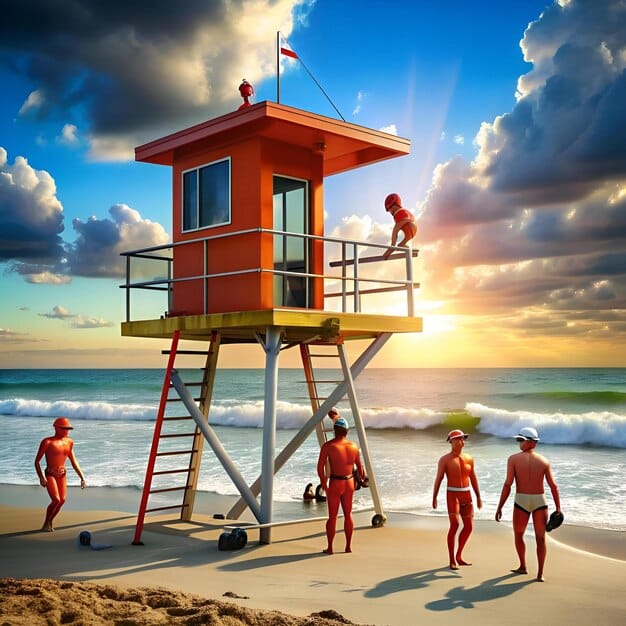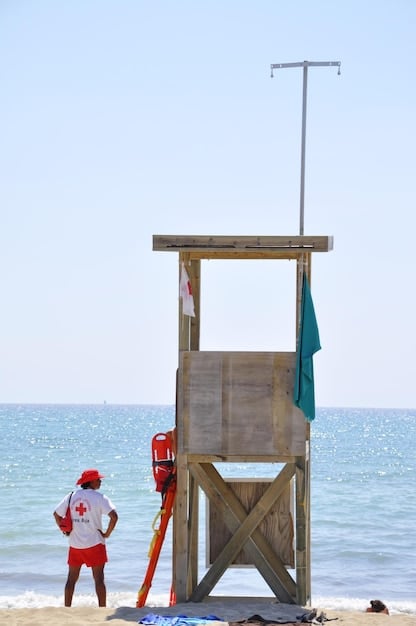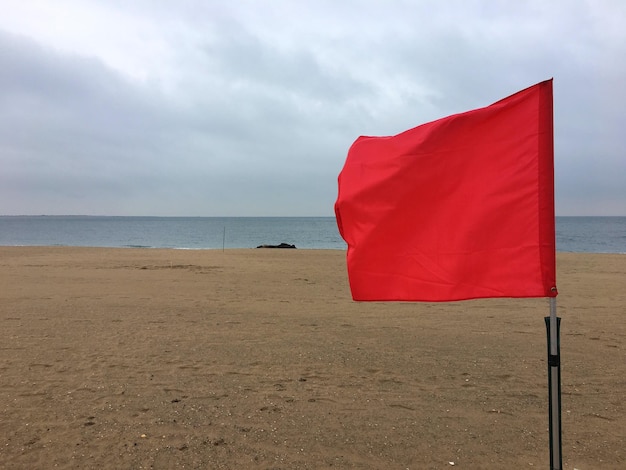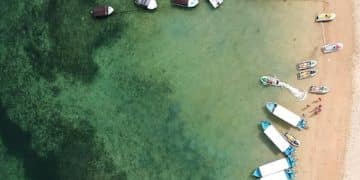Beach Safety Tips: Avoiding Rip Currents and Other Hazards This Season

Navigating coastal environments safely requires understanding and mitigating risks like rip currents and other hazards that can appear during beach season, necessitating vigilance and adherence to established safety guidelines for all visitors.
As the weather warms and the allure of sandy shores grows, beach safety becomes paramount. Understanding and implementing Beach Safety Tips: Avoiding Rip Currents and Other Hazards This Season is crucial for a fun and secure experience. While beaches offer immense joy and relaxation, they also present potential dangers that demand respect and awareness.
Understanding rip currents: The silent threat
Rip currents are powerful, narrow channels of water moving quickly away from shore, often appearing calm on the surface, which can deceive unsuspecting swimmers. Identifying these currents is the first crucial step toward avoiding their peril. They are one of the leading causes of rescues and fatalities at beaches worldwide.
These currents form when waves break near the shoreline, pushing water towards the land. As this water piles up, it needs a way to return to the sea. Often, it finds a path through a narrow, deeper section of the seabed, creating a strong, fast-moving current. Understanding their behavior is key to beach safety.
How rip currents form and behave
Rip currents are complex phenomena, influenced by various factors like wave height, tide, and coastal topography. They don’t pull swimmers under the water; rather, they pull them away from the shore, often faster than an Olympic swimmer can swim. This exhaustion from trying to fight the current is what leads to danger.
- Wave action: Larger waves often generate stronger rip currents as more water is pushed towards the shore, requiring a more forceful return path.
- Bottom topography: Gaps in sandbars, jetties, or piers can create natural channels for water to flow back out to sea, intensifying rip current formation.
- Tides: Changes in tide can influence rip current strength and location. Certain tidal conditions might exacerbate their power.
Identifying a rip current can be challenging. Look for a channel of churning, choppy water, an area of noticeable difference in water color, or a line of foam, seaweed, or debris moving steadily seaward. Sometimes, a break in the incoming wave pattern can also indicate a rip. If you suspect a rip current, avoid that area.
What to do if caught in a rip current
Panicking is the biggest mistake. If you find yourself caught in a rip current, conserve your energy. Do not try to swim directly against the current; it’s a battle you likely won’t win. Instead, remember the “flip, float, and follow” method or swim parallel to the shore until you are out of the pull. Once free, swim at an angle away from the current and towards the shore.
Always alert a lifeguard if you see someone in distress. They are trained professionals equipped to handle such emergencies. Educating yourself and your family about rip current safety ahead of time can make a significant difference. Knowledge empowers you to ensure a safer beach experience.
Staying calm is paramount. Floating on your back can save energy and help you think clearly about your next move. Signal for help immediately by waving your arms. Rip currents are dangerous, but they are escapable with the right knowledge and a calm approach. Awareness is your first line of defense.
General beach safety guidelines: Beyond the waves
While rip currents are a major concern, beach safety extends to a multitude of other hazards, from sun exposure to marine life and unpredictable weather. A comprehensive approach ensures a safer outing for everyone. Preparation is key to mitigating these risks effectively.
Before heading to the beach, always check local weather forecasts and beach advisories. Conditions can change rapidly, and what seemed like a perfect day can quickly turn hazardous. Pay attention to any posted warnings or flags, as they communicate important safety information swiftly.
Sun safety and heat-related illnesses
The sun’s powerful ultraviolet (UV) rays can cause severe sunburn, premature skin aging, and increase the risk of skin cancer. Heatstroke and heat exhaustion are also significant concerns, especially in hot, humid conditions. Protecting yourself starts with preparation.
- Use sunscreen: Apply broad-spectrum sunscreen with an SPF of 30 or higher liberally and reapply every two hours, or more often if swimming or sweating.
- Seek shade: Utilize umbrellas, tents, or natural shade during peak sun hours (typically between 10 AM and 4 PM).
- Stay hydrated: Drink plenty of water throughout the day, even if you don’t feel thirsty, to prevent dehydration.
Wearing protective clothing, such as wide-brimmed hats, sunglasses, and long-sleeved shirts, can offer an additional layer of defense. Keep an eye on children and the elderly, as they are more susceptible to heat-related illnesses. Immediate action can prevent serious conditions.
Marine life and environmental hazards
Beaches are diverse ecosystems, home to various marine creatures, some of which can pose risks. Knowing what to look out for and how to react can prevent painful encounters. The shoreline itself can also present environmental hazards.
Jellyfish stings, encounters with sharp shells, or stepping on camouflaged marine animals such as stingrays are common concerns. Always shuffle your feet when walking through shallow water to scare away stingrays. Avoid touching any marine life, even if it appears harmless. Some animals only sting as a defense mechanism.
Broken glass, sharp rocks, and hot sand are also environmental hazards that can cause injury. Wearing beach shoes or sandals can protect your feet. Always dispose of trash properly to keep the beach clean and safe for everyone. Respecting the environment means protecting yourself and others.

Supervision and water awareness: Crucial for all ages
Consistent supervision, especially of children, is non-negotiable at the beach. Water environments can be deceivingly dangerous, and even strong swimmers can find themselves in trouble. Active supervision means being attentive and within arm’s reach of young children.
Drowning is often silent, a critical point many people overlook. There’s usually no splashing or yelling, just a quiet struggle. This makes constant, vigilant supervision even more important. Never rely solely on flotation devices or older siblings to supervise.
Vigilance for children and weak swimmers
Children and weak swimmers need extra attention. Designate a “water watcher” who is solely responsible for monitoring those in the water, without distractions. This role should rotate among adults to prevent fatigue. This active attention is vital for preventing accidents.
- Stay close: Always remain within arm’s reach of young children and inexperienced swimmers.
- Use life jackets: Ensure children and weak swimmers wear U.S. Coast Guard-approved life jackets, especially near or in unpredictable waters.
- Establish rules: Set clear rules for children about where they can swim, how deep they can go, and never swimming alone.
Educate children about water safety from an early age. Teach them to ask for permission before entering the water and to always swim near a lifeguard. These fundamental lessons empower them to make safer choices as they grow.
Even in shallow water, risks exist. A sudden drop-off or an unexpected wave can quickly lead to a dangerous situation. Teach children to identify and avoid visible hazards. Reinforce the message that the ocean is powerful and demands respect, regardless of water depth.
Recognizing distressed swimmers
Knowing the signs of a distressed swimmer is as important as knowing what to do if you are in trouble. A person struggling to stay above water may not be able to call for help. Key indicators include head low in the water, gasping for air, or eyes unfocused.
Often, they will be facing the shore, trying to propel themselves towards it. Their arms may be extended to the side, pressing down on the water to keep their mouth above the surface. Recognizing these non-verbal cues can save a life. Don’t assume someone is just playing.
If you see someone in distress, alert a lifeguard immediately. If no lifeguard is present, and you are trained in water rescue, consider carefully before attempting a rescue. A non-diving assist with a flotation device is often the safest approach. Never put yourself in danger.
Understanding beach flags and warnings: Your coastal communication
Beach flag systems are universal signals designed to communicate current water conditions and potential hazards quickly. Recognizing and understanding these flags is a fundamental aspect of beach safety. They are your immediate warning system.
Ignoring beach flags can have severe consequences, as they represent official assessments of danger. Always look for the flags as soon as you arrive at the beach and before entering the water. Conditions can change throughout the day, so remain observant.
Common beach flag meanings
Different colors indicate varying levels of danger. While specific interpretations may vary slightly by region, the core meanings are largely consistent across most coastal areas. Learning these meanings is a simple yet effective way to protect yourself.
- Green flag: Generally calm conditions, low hazard. However, caution is always advised.
- Yellow flag: Medium hazard, moderate surf and/or currents. Weak swimmers should stay out of the water.
- Red flag: High hazard, dangerous conditions such as strong currents or high surf. Swimming is strongly discouraged or prohibited.
- Double red flag: Water closed to the public due to extreme dangers. Entering the water can result in fines and is highly dangerous.
- Purple flag: Presence of dangerous marine life, such as jellyfish, stingrays, or dangerous fish.
In some areas, black or orange flags might be used to indicate specific dangers or environmental warnings. Always familiarize yourself with the local flag system upon arrival. If in doubt, ask a lifeguard or local authorities for clarification.

Heeding official warnings and advisories
Beach warnings aren’t just about flags. Lifeguards often provide verbal warnings, and signage may indicate specific, localized dangers not covered by the flag system. Pay attention to all forms of communication. These are put in place for your protection.
During stormy weather or when a hurricane is approaching, beaches will often be completely closed. Disregarding these closures is not only illegal but extremely dangerous. Coastal storm surges and powerful waves can be deadly even far from the storm’s center.
Local authorities may issue advisories for water quality issues, such as bacteria levels or harmful algal blooms. These can pose health risks. Checking local government or park service websites for daily updates is a proactive measure that can ensure a safe beach visit.
First aid and emergency preparedness: Ready for the unexpected
Even with the best safety measures, accidents can happen. Being prepared with basic first aid knowledge and knowing how to respond in an emergency can significantly reduce the severity of injuries and potentially save lives. Every beachgoer should have some level of preparedness.
Carrying a basic first aid kit is highly recommended. It should include items like bandages, antiseptic wipes, pain relievers, and any personal medications. Knowing how to use these items is just as important as having them.
Basic first aid for common beach injuries
Minor cuts, scrapes, and stings are common at the beach. Prompt and proper first aid can prevent infection and alleviate discomfort. Always clean wounds thoroughly with fresh water and apply an antiseptic before bandaging.
- Sunburn: Apply cool compresses and aloe vera or a soothing lotion. Stay out of the sun until skin heals. Severe sunburns might require medical attention.
- Jellyfish stings: Rinse with vinegar (if available and recommended for the specific species) or saltwater, not fresh water. Remove tentacles carefully, and apply a hot pack. Seek medical attention if symptoms worsen.
- Cuts and scrapes: Clean with fresh water and mild soap, then apply an antiseptic and cover with a sterile bandage to prevent infection.
For more serious injuries, such as deep cuts, sprains, or suspected fractures, seek professional medical attention immediately. Do not attempt to move someone with a suspected spinal injury unless absolutely necessary due to immediate danger.
Always carry a small supply of fresh water to clean wounds if no other source is available. Inform lifeguards or beach staff of any injuries, even minor ones, especially if you are concerned about a possible reaction to a marine sting. Reporting helps monitor beach conditions.
Emergency contacts and communication
Before heading to the beach, establish a meeting point in case family members get separated. Ensure everyone knows whom to contact and how to reach them. Cell service can be spotty in some coastal areas, so have a backup plan.
Teach children how to recognize a lifeguard and whom to approach if they get lost. Consider writing your phone number on a child’s arm or a wristband. This quick step can save valuable time during a stressful situation.
Always know the address or specific location of the beach you are visiting. This information is critical for emergency services to locate you quickly. In an emergency, dial 911 or your local emergency number immediately. Provide clear, concise information about the situation and your location. Timely communication can be life-saving.
Responsible beach etiquette: Sharing the coast safely
Beach safety isn’t solely about avoiding hazards; it also involves courtesy and responsible behavior that contributes to the safety and enjoyment of all visitors. Adhering to good beach etiquette ensures a pleasant and safe environment for everyone.
Leaving no trace is perhaps the most fundamental rule. Whatever you bring to the beach, take it with you when you leave. This simple act prevents injuries from litter and protects marine life from pollution. It keeps the beach clean for future enjoyment.
Respecting wildlife and protecting the environment
Beaches are natural habitats for a variety of plants and animals. Disturbing nests, harming wildlife, or polluting their environment can have severe consequences for the ecosystem. Observe wildlife from a distance and avoid feeding animals, as it can disrupt their natural behaviors.
- Stay on designated paths: Avoid walking on dunes or fragile vegetation, as this erosion can destabilize the coastline and harm sensitive ecosystems.
- Dispose of waste properly: Use designated trash and recycling bins. If bins are full or unavailable, take your trash with you.
- No fires or illegal activities: Adhere to all local regulations regarding fires, alcohol consumption, and other activities.
Education about local marine conservation efforts can also enhance your beach experience. Many areas have volunteers who protect nesting sea turtles or monitor bird populations. Supporting these initiatives contributes to long-term coastal health.
Beach clean-ups are also a great way to give back. Participating in or organizing one helps maintain the beauty and safety of our shores. Every piece of trash removed is a potential hazard averted for wildlife and people alike. Be a part of the solution, not the pollution.
Consideration for fellow beachgoers
Sharing public spaces requires consideration. Keep noise levels down, especially near residential areas or other families. Be mindful of personal space and avoid setting up too close to others, particularly when the beach is crowded. A thoughtful approach benefits everyone.
Supervise pets if they are allowed on the beach, and always clean up after them. Dogs should be on a leash in designated areas. Their presence should not infringe on others’ ability to enjoy the beach safely. Check local regulations regarding pets on beaches.
When playing sports or games, choose areas away from where people are relaxing or swimming to avoid accidental injury. If you’re flying a kite, ensure it’s far from power lines or other beachgoers. A little foresight can prevent many conflicts and accidents.
Finally, respect local customs and rules. If there are designated swimming areas, stay within them. If a particular area is closed for conservation or safety, respect the signs. This collective respect ensures that beaches remain enjoyable and safe for all.
| Key Point | Brief Description |
|---|---|
| 🌊 Rip Current Safety | Learn to identify rip currents and how to react if caught: swim parallel to shore. |
| ☀️ Sun Protection | Apply sunscreen regularly, seek shade during peak hours, and stay hydrated to avoid heat stress. |
| 👀 Vigilant Supervision | Actively supervise children and weak swimmers; drowning is often silent. |
| 🚩 Understand Flags | Heed beach warning flags and official advisories for current conditions and hazards. |
Frequently asked questions (FAQ)
A rip current is a strong, narrow current of water flowing rapidly away from the shore. You can often spot one by looking for a channel of churning, choppy water, a line of foam or debris moving steadily seaward, or a noticeable difference in water color. Sometimes, a break in incoming wave patterns can also indicate a rip.
If caught in a rip current, stay calm and don’t fight the current by trying to swim directly back to shore. Instead, swim parallel to the shore until you are out of the current’s pull. Once free, swim diagonally back to the shore. If you can’t swim to safety, float and wave for help.
It is always safest to swim at beaches where lifeguards are on duty. If no lifeguards are present, exercise extreme caution. Only swim if you are a strong swimmer and with a buddy. Be extra vigilant for changing conditions, marine life, and potential rip currents. “Swim near a lifeguard” is a golden rule for beach safety.
Beach flags indicate current water conditions: Green means low hazard, calm conditions; Yellow indicates medium hazard, moderate surf/currents (weak swimmers should stay out); Red signifies high hazard, dangerous conditions; Double Red means water is closed. A Purple flag warns of dangerous marine life. Always check flags before entering the water.
Protecting yourself from the sun involves applying broad-spectrum sunscreen with SPF 30 or higher liberally and reapplying every two hours. Seek shade during peak sun hours (10 AM to 4 PM), wear protective clothing like hats and sunglasses, and stay well-hydrated by drinking plenty of water throughout the day to prevent heat-related illnesses.
Conclusion
A day at the beach provides an unparalleled opportunity for relaxation and enjoyment, but it requires a proactive approach to safety. By understanding and respecting the power of the ocean, particularly regarding rip currents, and adhering to general safety guidelines, visitors can mitigate risks significantly. From diligent sun protection and vigilant supervision—especially of children—to understanding beach flags and being prepared for minor emergencies, every action contributes to a safer environment. Responsible beach etiquette, including respecting wildlife and fellow beachgoers, ensures that our coastal areas remain beautiful and accessible for all. Remember that preparedness, awareness, and respect for the natural environment are your best allies for a fun, safe, and memorable beach season.





